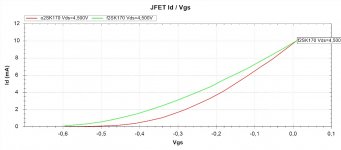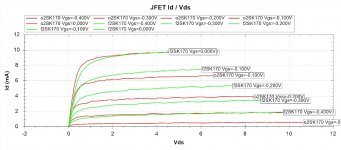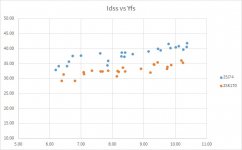Measure if Idss is in the grade range, also visual inspection helps.
That's a start, but the problem is that the easiest way to fake a 2SK170 is to remark a similar part with inferior specs. Without getting too paranoid about it, if Idss is out of range it indicates fakes, but unfortunately Idss in range doesn't prove beyond all doubt that they are genuine
Checking a J-FET is a J-FET shouldn't be to difficult, but checking exactly what it is supposed to be is an entirely different matter.
This is the problem with parts of unknown province, you always wonder as that element of doubt is always there.
You could rig a test circuit up and check they behave correctly at a basic level, check that they are symmetrical and operate the same either way around. Check the pinch off voltage.
You could even build a dynamic test circuit (small single J-FET amplifier).
Next procure some known genuine devices and compare performance.
This is the problem with parts of unknown province, you always wonder as that element of doubt is always there.
You could rig a test circuit up and check they behave correctly at a basic level, check that they are symmetrical and operate the same either way around. Check the pinch off voltage.
You could even build a dynamic test circuit (small single J-FET amplifier).
Next procure some known genuine devices and compare performance.
I'm wondering if anybody can advise me what tests I can do to determine whether a parcel of 500x 2SK170s I bought from a supposedly reputable source ... are genuine ... or fake.
Thanks,
Andy
Measure if Idss is in the grade range, also visual inspection helps.
Yes, as Merlin has already said, Idss measurement will for almost sure tell you if the part is genuine or not. If the Idss measurement is followed by Gm measurement, then you may be sure what you have.
About 10 years ago I bought a set of "2SK170BL" and "2SJ74BL" parts from an internet seller in Taiwan. They were all fakes. I tested them in a test-setup derived from one of my preamps
PRE3 complementary-differential preamplifier
All the parts were both very noisy an had very high distortion in the test circuit.
EUVL Patrick would know how to check.
Jan
PMA already showed you a simple test.
You can check the Idss against Vp from the datasheet.
That is a good start.
If you want to test more parameters then take a look here :
FET Measurements with Just A DMM
Or send a few to someone who has a curve tracer and willing to test for you.
But if you paid less than 3USD a piece then it is very likely to be fake.
Patrick
Measuring the noise performance in the end-circuit would be useful - if it performs according to spec, do you actually care if they are fake!?
You can feed a known signal source through inverse RIAA network and or low-noise attenuator, into the amp circuit that uses the 2SK170's - then compare noise between devices (assuming you have known good 2SK170's to compare against).
You can feed a known signal source through inverse RIAA network and or low-noise attenuator, into the amp circuit that uses the 2SK170's - then compare noise between devices (assuming you have known good 2SK170's to compare against).
Simple JFET test circuit attached. Measure both Idss and Vp.
Thanks very much for showing me this test, PMA.
Just a couple of Qs, please:
1. When I'm measuring the mA value, can I do this by inserting, say, a 500 ohm resistor between the Drain and the +12/15v and measuring the voltage drop across this res? (That's the way I currently measure Idss, in order to match (genuine!
2. When I'm doing the second step and measuring Vp ... if it's a genuine 2SK170, what should V (on your diagram) measure?
Thanks,
Andy
> measuring the mA value, can I do this by inserting, say, a 500 ohm resistor
Ideally the VDS should be the value from the datasheet. (FET curves are not dead flat.) This most conveniently means using that volts of a battery, and the *smallest* possible sense resistor. Which really means, use a current meter!
While my old VTVM had no Amps, it is a standard frill on DMMs. Random clicks in Amazon found Neoteck 8233D PRO, US$20, with 200uA/2000uA/20mA/200mA/10A ranges. Since all these are now made closer to you than to me, you can surely find a similar meter at comparable price. You need three meters anyway. (A tech with two meters is like the man with two watches, never know which is right.) On the FET test you can read Idss and Vgs without switching leads or ranges. (NEVER expose a current meter to a voltage source!!) When burning vacuum tubes you can watch B+ and Ik at the same time; this has saved me some smoke. You can't save transistors, they smoke too fast, but many times you want to watch + and - supply, or idle current and DC offset, or compare stereo L and R to diagnose unbalance.
Ideally the VDS should be the value from the datasheet. (FET curves are not dead flat.) This most conveniently means using that volts of a battery, and the *smallest* possible sense resistor. Which really means, use a current meter!
While my old VTVM had no Amps, it is a standard frill on DMMs. Random clicks in Amazon found Neoteck 8233D PRO, US$20, with 200uA/2000uA/20mA/200mA/10A ranges. Since all these are now made closer to you than to me, you can surely find a similar meter at comparable price. You need three meters anyway. (A tech with two meters is like the man with two watches, never know which is right.) On the FET test you can read Idss and Vgs without switching leads or ranges. (NEVER expose a current meter to a voltage source!!) When burning vacuum tubes you can watch B+ and Ik at the same time; this has saved me some smoke. You can't save transistors, they smoke too fast, but many times you want to watch + and - supply, or idle current and DC offset, or compare stereo L and R to diagnose unbalance.
Send a picture of you JFET, I will tell you is it genuine or not - with very high probability.
As people send here, IDSS should be in the datasheet range - I measured thousands of JFETs, and have never seen genuine Toshiba outside the range. 2SK170V jfet behaviour
is usually: if IDSS < 13 ma, current grows slowly during 5-10 seconds, if 13mA and more - it goes down for 5-10 seconds.
As people send here, IDSS should be in the datasheet range - I measured thousands of JFETs, and have never seen genuine Toshiba outside the range. 2SK170V jfet behaviour
is usually: if IDSS < 13 ma, current grows slowly during 5-10 seconds, if 13mA and more - it goes down for 5-10 seconds.
... if it's a genuine 2SK170, what should V (on your diagram) measure?...
Read the datasheet.
https://www.mouser.com/ds/2/408/6909-57550.pdf
Gate-source cut-off voltage VGS (OFF): VDS = 10 V, ID = 0.1 μA −0.2 to −1.5 V
"Vp" is pinch-off, Vgs(off) is the same concept. In practice each maker may pick different values of "off" (since we can never really pinch to zero).
So set VDS to 10 (or 9) volts. Since they measure "cutoff" as really 0.1uA, ideally we would scale the "-15V" supply 10X higher than expected Vp, so 15V. Then use 150 MegOhm resistor. However meter loading may be appreciable, and we'd never really run near pinch-off. Use 10Meg if handy, 1Meg if you must, and know that Vp will read a little less than what the factory measures. See page 2. We can't really read these graphs down to 0.1uA, but you see the long toe.
Idss and Vp go together. They can't control the diffusion too well. (Which is part of why fakes are easy to pass.) If it is fat you get high Idss and need high Vgs to pinch-off (Vp); a thin channel is low Idss and doesn't need high Vp. The 2SK170 is sorted into GR BL and V bins of Idss. Given a bucket of reject FETs it is easy to find ones which will meet one OR the other parameter of 2SK170, but not both. If it comes near '170 specs both ways and is not leaky or hissy, it is "close enough to a '170" for most audio purposes.
I'm wondering if anybody can advise me what tests I can do to determine whether a parcel of 500x 2SK170s I bought from a supposedly reputable source ... are genuine ... or fake.
Thanks,
Andy
Before rigging an electronic test setup, measure the diameter, height and thickness of the epoxy package with a caliper first. Compare your numbers with the Toshiba datasheet. If it passes this acid test then go to the next step.
Fake and remarked parts usually measure significantly less on this department. Fake parts usually use less material, not more. It is all about profit
Thank you, guys, for all your input. 
Doing the measuring which ej25awd recommended, suggests that they are fakes. I measured three and then measured one which I had bought from Farnell a few years ago (so should be genuine!).
Suspect ones measure (W / D / H):
* 4.62 / 3.52 / 4.59 mm
* 4.72 / 3.60 / 4.59 mm
* 4.67 / 3.59 / 4.58 mm.
The Farnell one measured:
* 5.00 / 3.88 / 4.65 mm.
Toshiba spec sheet says:
* 5.1 max / 4.1 max / 4.7 max mm.
Alweit, I have attached a pic I took of 3 of the suspect JFETs. I'm afraid my camera is not good enough to show the writing on the package.
BTW, I believe I twice bought 40 or 50 matched JFETs from you, 5 to 7 years ago (through eBay) - I recognise your ID. Do you still offer this service? (I looked for you a year ago but couldn't locate you - which led me to my purchase of 500 unmatched 2SK170s.)
Thanks again, everyone.
Andy
Doing the measuring which ej25awd recommended, suggests that they are fakes. I measured three and then measured one which I had bought from Farnell a few years ago (so should be genuine!).
Suspect ones measure (W / D / H):
* 4.62 / 3.52 / 4.59 mm
* 4.72 / 3.60 / 4.59 mm
* 4.67 / 3.59 / 4.58 mm.
The Farnell one measured:
* 5.00 / 3.88 / 4.65 mm.
Toshiba spec sheet says:
* 5.1 max / 4.1 max / 4.7 max mm.
Alweit, I have attached a pic I took of 3 of the suspect JFETs. I'm afraid my camera is not good enough to show the writing on the package.
BTW, I believe I twice bought 40 or 50 matched JFETs from you, 5 to 7 years ago (through eBay) - I recognise your ID. Do you still offer this service? (I looked for you a year ago but couldn't locate you - which led me to my purchase of 500 unmatched 2SK170s.)
Thanks again, everyone.
Andy
Sometimes fakes are damn good and close to original specs, even outside dimensions are within specifications. Measuring only Idss is not enough.
o2SK170 = original Toshiba
f2SK170 = fake
o2SK170 = original Toshiba
f2SK170 = fake
Attachments
Last edited:
- Home
- Design & Build
- Parts
- How to identify fake JFETs?


